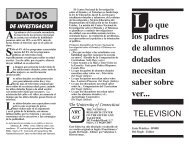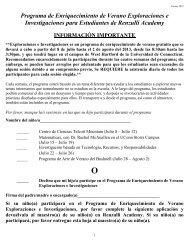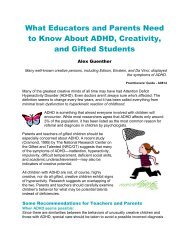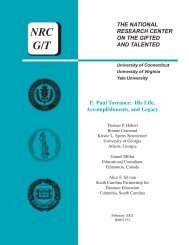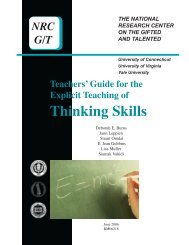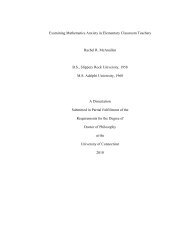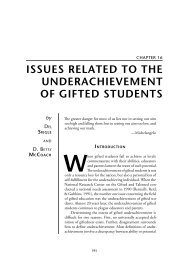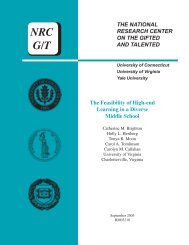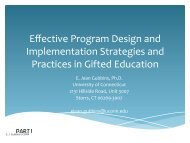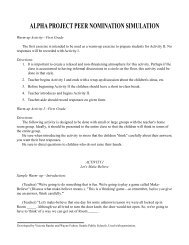Giftedness and High School Dropouts - Neag Center for Gifted ...
Giftedness and High School Dropouts - Neag Center for Gifted ...
Giftedness and High School Dropouts - Neag Center for Gifted ...
Create successful ePaper yourself
Turn your PDF publications into a flip-book with our unique Google optimized e-Paper software.
57<br />
Variables in the Study<br />
Reasons <strong>for</strong> leaving school (F2D9AA-V): These variables were obtained from<br />
the students' responses to the question, "Here are some reasons other people have given<br />
<strong>for</strong> leaving school. Which of these would you say applied to you" Students responded<br />
either "yes" or "no" on each item.<br />
Parents' reactions (F2D22A-M): These variables were obtained from the students'<br />
responses to the question, "Did your parents or guardians do any of the following the last<br />
time you stopped going to school" Students responded either "yes" or "no" on each<br />
item.<br />
Use of time (F2D35A, B, E): These variables were obtained from the question,<br />
"How often do you spend time on the following activities" A: Using personal<br />
computers, not including playing video/computer games, B: Working on hobbies, arts, or<br />
crafts on your own, E: Doing volunteer or community service. These were coded 1<br />
(never/rarely), 2 (less than once a week), 3 (once or twice a week) <strong>and</strong> 4 (every day or<br />
almost every day).<br />
Academic plans (F2D33BA): This variable was obtained from the question, "Do<br />
you plan to go back to school to get a high school diploma" This was dummy coded 1<br />
(yes) <strong>and</strong> 2 (no).<br />
Future career plan (F2D40A): This variable was obtained from the question,<br />
"Which of the categories below comes closest to describing the job or occupation that<br />
you expect or plan to have when you are 30 years old Even if you are not sure, circle<br />
your best guess." The respondents were supposed to choose one among 19 categories.<br />
Self-concept <strong>and</strong> locus of control (F2D57A-M): This composite variable included<br />
13 questions related to self-concept <strong>and</strong> locus of control using a 4-point Likert scale.<br />
Relationship with parents (F2D35H): This variable was obtained from the<br />
question, "How often do you spend time on talking or doing things with your mother or<br />
father" This was coded 1 (never/rarely), 2 (less than once a week), 3 (once or twice a<br />
week), <strong>and</strong> 4 (every day or almost every day).<br />
Peer relationship (F2D35G): This variable was obtained from the question, "How<br />
often do you spend time talking or doing things with your friends" This was coded 1<br />
(never/rarely), 2 (less than once a week), 3 (once or twice a week), <strong>and</strong> 4 (every day or<br />
almost every day).<br />
Socioeconomic status (F2SES3Q): This variable was constructed using the<br />
Second Follow-up Parent Questionnaire data, <strong>and</strong> it incorporates the 1989 revision of<br />
Duncan's Socioeconomic Index (SEI). This variable was a composite of five variables:<br />
father's occupation, father's educational level, mother's occupation, mother's educational<br />
level, <strong>and</strong> family income (NECS, 1994a).



